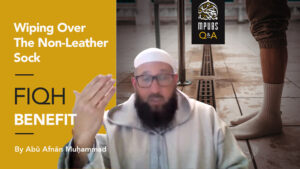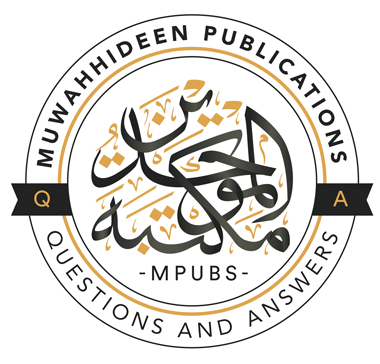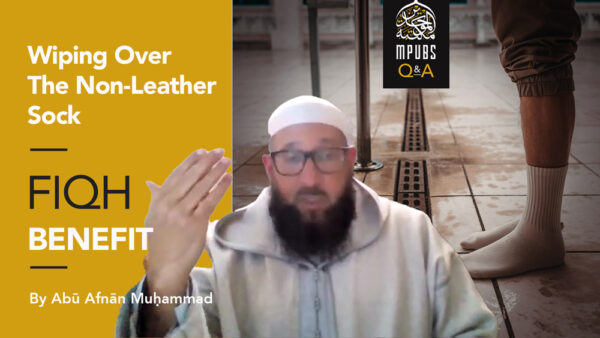Pivotal Quote
❝…the majority of people in the world do not wear leather socks anymore. So the majority of people who are going to be faced with this issue in today’s time are going to be wearing some type of wool socks or cotton socks. The legitimacy or rationale for wearing those socks is the same rationale for wearing the khufs. That was what Ibn Al-Qayyim said, that the ʿumdah – the bulk or strength of the proof of Imām Aḥmad’s position was the fact that the ṣaḥābah did it. And we know that the ṣaḥābah (رضي الله عنهم) are the most knowledgeable people of the sunnah of the Prophet (ﷺ) and its application..❞
Wednesday 18th December 2024
 The questioner asked: Is it correct that with regard to making masḥ or wiping over the sock, that the sock must be made of leather because most of the narrations mention leather socks when it comes to wiping, and that one of the conditions is that it must not allow water to pass through it? Also, what about the sock that has holes in it? Bārak Allāhu Fīkum.
The questioner asked: Is it correct that with regard to making masḥ or wiping over the sock, that the sock must be made of leather because most of the narrations mention leather socks when it comes to wiping, and that one of the conditions is that it must not allow water to pass through it? Also, what about the sock that has holes in it? Bārak Allāhu Fīkum.
Answer: Bārak Allāhu Fīkum, jazāk Allāh Khair. This is an important issue especially as the weather is getting cooler and people are wearing socks during these days. It is an important question. The ʿulamāʾ mention, and you find specifically in the books of the Ḥanbalīs, that
يجوز المسح على الخفين وما أشبههما
“It is permissible to wipe upon the khuffayn (leather socks) and that which is similar to al-khuffayn.”
This was the opinion of the Ḥanbalīs and the scholars of ḥadīth. The ʿulamāʾ mention that this comes as a proof for the permissibility of wiping over something besides the khufayn (that is similar to it) and that it is not a condition that it be khufs made from leather. Khuf refers to what is worn on the foot, and is made from leather.
Ḥadīth of Thawbān:
It comes in a ḥadīth of Thawbān (رضى الله عنه) that the Prophet (ﷺ) ordered a military expedition, and its members were then afflicted by cold weather. So they described to the Prophet (ﷺ) what they experienced from coldness. As it says in this ḥadīth, the Prophet (ﷺ) said, “أَمَرَهُمْ أَنْ يَمْسَحُوا عَلَى الْعَصَائِبِ وَالتَّسَاخِينِ”. The Prophet (ﷺ) commanded them to wipe “ʿalā al-ʿaṣā’ib wa at-tasākhīn”. Al-ʿaṣā’ib means ‘the turbans’ and al-tasākhīn literally means that which somebody wears to keep his feet warm. This ḥadīth was narrated by Abī Dāwūd, Ḥākim and Imām Aḥmad. Ḥākim, Adh-Dhahabī, an-Nawawī and also Shaykh al-Albānī (رحمة الله عليهم) all deemed it as being ṣaḥīḥ.
Meaning of the word Tasākhīn (تَّسَاخِينِ):
What is understood from the word tasākhīn? Some scholars like al-Khaṭṭābī mention that tasākhīn refers to al-khuf as well as al-jawārib which means socks – either from wool or cotton or anything that is not leather, and is worn on the foot. Let us say a person mentioned what you mentioned in the question. Let us say they deem this ḥadīth as being weak, or they follow the opinion of scholars who said that this ḥadīth was weak, and they said that the majority of narrations specifically have the wording of al-khuffayn or the leather socks. So even if we deem this ḥadīth as being authentic, this tasākhīn – what is worn on the feet to keep warm, refers to khuffayn. So we understand this general statement of tasākhīn in light of the specific mention of khuffayn and nothing else.
Stronger Position based on ʾIjmā’ of the Ṣaḥābah and Qiyās:
Imām Aḥmad (رحمه الله تعالى) mentioned that it is thābit, meaning that it is authentically narrated from seven or eight of the ṣaḥābah that they wiped on the socks and there was no inkār (reproaching) made upon them for doing so. This is what the ʿulamāʾ of uṣūl refer to as ʾIjmā’ as-Sukūtī. Ibn Al-Qayyim (رحمه الله تعالى) mentioned that even Imām Aḥmad (رحمه الله) saw this ḥadīth of Thawbān as being weak but his ʿumdah – the bulk of his proof was the action of the ṣaḥābah. Not only the action of the ṣaḥābah, but qiyās al-jalī – clear, authentic, legitimate qiyās because there is no difference between al-khuf (leather socks) and al-jawrib (socks made of cotton or wool) with regards to why a person wears it.
A person wears khuf, leather socks but in all practical purposes, the majority of people in the world do not wear leather socks anymore. So the majority of people who are going to be faced with this issue in today’s time are going to be wearing some type of wool socks or cotton socks. The legitimacy or rationale for wearing those socks is the same rationale for wearing the khufs. That was what Ibn Al-Qayyim said, that the ʿumdah – the bulk or strength of the proof of Imām Aḥmad’s position was the fact that the ṣaḥābah did it. And we know that the ṣaḥābah (رضي الله عنهم) are the most knowledgeable people of the sunnah of the Prophet (ﷺ) and its application.
So if a person asks, ‘what was the understanding of these narrations that only mention the khufs?’ Then the understanding and practice of that was in light of what these seven or eight ṣaḥābah did, where they wiped on the khufs without any inkār being made upon them for doing so. That is the strongest opinion and it was the opinion of the Ḥanbalī Madhhab and other scholars.

